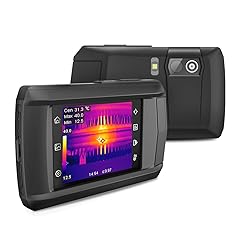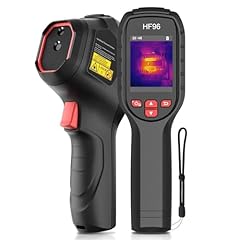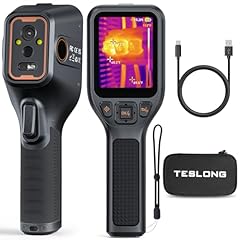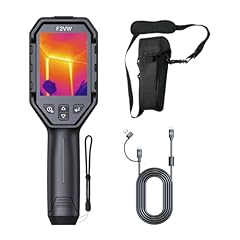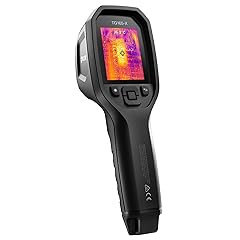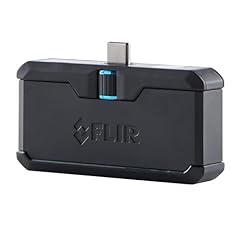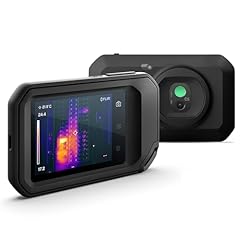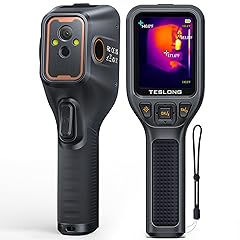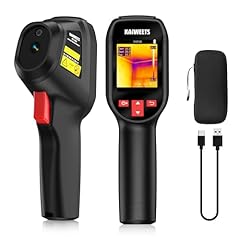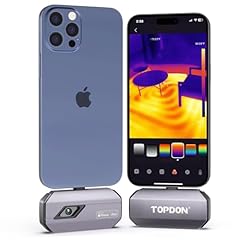-
1
Best Overall High-resolution imagery for detailed thermal analysis.
High-resolution imagery for detailed thermal analysis. Intuitive 3.5" touch screen for easy navigation.
Intuitive 3.5" touch screen for easy navigation. Wide temperature range suits diverse applications.
Wide temperature range suits diverse applications. -
2
Best Affordable Super resolution enhances image clarity significantly.
Super resolution enhances image clarity significantly. Long 8-hour battery life for extended use.
Long 8-hour battery life for extended use. Wide temperature range from -4°F to 1022°F.
Wide temperature range from -4°F to 1022°F. -
3
Hot Deal High-resolution thermal imaging at 256 x 192.
High-resolution thermal imaging at 256 x 192. Dual-light fusion for clearer visuals.
Dual-light fusion for clearer visuals. Smooth 25Hz refresh rate for real-time use.
Smooth 25Hz refresh rate for real-time use. -
4
 High-resolution thermal images with 256x192 IR resolution.
High-resolution thermal images with 256x192 IR resolution. Convenient dual-camera system for detailed analysis.
Convenient dual-camera system for detailed analysis. Ample 16 GB storage for extensive image saving.
Ample 16 GB storage for extensive image saving. -
5
 Clear thermal images with Bullseye laser accuracy.
Clear thermal images with Bullseye laser accuracy. Durable design suitable for commercial use.
Durable design suitable for commercial use. Efficient for building, HVAC, and electrical inspections.
Efficient for building, HVAC, and electrical inspections. -
6
 High-resolution thermal imaging enhances detail clarity.
High-resolution thermal imaging enhances detail clarity. Compatible with newer iPhone models via USB-C.
Compatible with newer iPhone models via USB-C. Compact and portable for on-the-go use.
Compact and portable for on-the-go use. -
7
 High-resolution imaging for precise temperature readings.
High-resolution imaging for precise temperature readings. Compact design enhances portability and ease of use.
Compact design enhances portability and ease of use. WiFi connectivity enables seamless data sharing.
WiFi connectivity enables seamless data sharing. -
8
Popular High-resolution imaging for detailed thermal views.
High-resolution imaging for detailed thermal views. Smooth 25 Hz refresh rate for real-time analysis.
Smooth 25 Hz refresh rate for real-time analysis. Large 3.2" screen for easy viewing.
Large 3.2" screen for easy viewing. -
9
 High-resolution display for detailed thermal images.
High-resolution display for detailed thermal images. Wide temperature range captures extreme conditions.
Wide temperature range captures extreme conditions. Long battery life ensures extended use.
Long battery life ensures extended use. -
10
 High-resolution imaging enhances detail clarity.
High-resolution imaging enhances detail clarity. Wide temperature range for versatile applications.
Wide temperature range for versatile applications. Convenient compatibility with Type-C devices.
Convenient compatibility with Type-C devices.
Overview of Thermal Camera
In today's world, thermal cameras are becoming increasingly valuable tools for a variety of purposes. Whether you're a professional needing to detect heat leaks in buildings, an outdoor enthusiast wanting to spot wildlife in low-light conditions, or a homeowner interested in enhancing security, these versatile devices offer a glimpse into the invisible world of thermal energy. Thermal cameras allow users to capture images based on heat signatures rather than visible light, making them indispensable for both practical applications and innovative hobbies. This guide explores some of the best thermal cameras available, helping you choose the right one to meet your needs.Top Thermal Camera
• HSFTOOLS HF96 Thermal Imaging Camera• HP96 Thermal Imaging Camera• Teslong Thermal Imaging Camera 256x192 Dual-LightFAQ
Q: How can a thermal camera be used for home inspections?
A: A thermal camera is invaluable for home inspections as it detects heat variations, allowing you to spot issues like water leaks, insulation gaps, and electrical faults that aren't visible to the naked eye. This makes it a powerful tool for maintaining your home's efficiency and safety.
Q: What are the benefits of using a thermal camera in wildlife observation?
A: Using a thermal camera for wildlife observation allows you to see animals in their natural habitat, even in complete darkness, without disturbing them. It provides a unique perspective on animal behavior and is particularly useful for nocturnal wildlife studies.
Q: How does a thermal camera enhance security systems?
A: A thermal camera enhances security systems by detecting intruders through their body heat, even in complete darkness or adverse weather conditions. This capability reduces false alarms and increases the reliability of your security setup.
Q: Can a thermal camera be used for medical purposes?
A: Yes, a thermal camera can be used in medical settings to detect temperature variations on the skin, which can indicate inflammation, poor circulation, or infection. It's a non-invasive tool that helps in early diagnosis and monitoring of various health conditions.
Q: How does a thermal camera assist in firefighting operations?
A: In firefighting, a thermal camera is crucial for locating hotspots, victims, and safe passages through smoke-filled environments. It enhances visibility and safety for firefighters, aiding in efficient and effective rescue operations.

